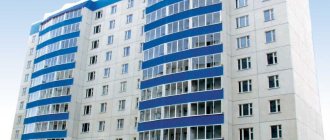The post-war period in the history of the USSR, among other things, is characterized by the active development of housing construction. Then the country's leadership faced a difficult task - providing the population with housing. In many ways, it has been accomplished and millions of Soviet families have received comfortable apartments. However, the bet was made precisely on the number of square meters being built. The quality of the housing built could not be said in a positive way.
In our time, this has led to the fact that most of the residential buildings that were built during the early and post-war USSR are already outdated, both physically and morally. At the same time, a significant part of apartment buildings not only require major repairs, for which, in fact, the corresponding program was created, but also become completely uninhabitable, showing signs of disrepair.
Within the framework of this article, we will consider the very definition of the concept of “emergency housing” and the criteria by which a house can be recognized as unsafe, as well as the procedure for recognizing an apartment building as dangerous for the future residence of residents.
The concept of accidents in a residential building
A building that was erected a long time ago and due to wear and tear or poor condition poses a danger during long-term residence is recognized as emergency. The breakdown of a residential building is a consequence of increased wear and tear of materials and structures. It is also recognized at prohibitive noise levels. Sometimes materials are used for flooring and wall materials in which the levels of harmful components are exceeded. And this always has a negative impact on the general condition of people.
Housing will be provided only if a decision is made that it is impossible to continue living in the house. According to Art. 16 Federal Law No. 185 uses a special resettlement program.
According to Decree of the Government of the Russian Federation No. 47 of January 28, 2006, only a house whose general condition is dangerous for the continued presence of people can be recognized as unsafe. More than half of the structures are worn out. This status is assigned by an interdepartmental commission working under the municipality. Independent examination cannot be considered the basis for granting status. Load-bearing structures are subject to change under the influence of not only natural wear and tear, but also external factors.
If no measures have been taken to strengthen the structure for a long period, the original strength is lost. As a result of the conclusion of the interdepartmental commission on the recognition of the house, emergency citizens are offered housing in new houses.
Criteria for recognizing a house as unsafe
The following criteria are determined when a house is recognized as subject to resettlement:
- wear exceeds 70%;
- sanitary standards are not met and cannot be met without relocating residents and major reconstruction;
- the building is located in an area of disaster or weather disasters;
- the house was partially destroyed as a result of exposure to the elements or fire;
- There is a busy highway nearby, creating increased noise.
Attention! If there is no central water supply or sewerage system, the house is not considered unsafe. This is also impossible if the room is smaller than the standards established for each family member. If such circumstances cannot be corrected, residents will be resettled on a different basis.
What is the difference between emergency housing and dilapidated housing?
The concept of emergency fund is established by law. This is a collection of premises of an apartment building that is subject to demolition based on issued orders. The local administration must provide information about the recognition of the building as dilapidated or unsafe. The object is checked by a commission based on the submitted application. Existing damage and serious breakdowns are taken into account. Since there is no special formula or methodology, each object is considered individually.
You can live in a dilapidated house for a longer period of time. If it is in serious disrepair, it must be vacated and demolished quickly. But there are situations when urgent resettlement occurs at a new address within 24 hours. Serious repairs or reconstruction measures are possible in dilapidated buildings if the load-bearing elements remain in good condition and it is possible to carry out work without violating their integrity.
Method for determining wear
It is not always possible to determine the wear and tear of a house with the naked eye!
Wear and tear assessments are carried out by real estate condition assessment services. By contacting such a company, you can invite an expert to your home and receive a certificate indicating the wear and tear of the building as a percentage.
This procedure allows you to accurately assess what costs will be needed in the future and whether it is advisable to purchase such a house. When assessing the deterioration of a building, many parameters are taken into account. Here are the main ones:
- The number of years that the building has been in use since completion of construction. Each year of operation, according to experts, increases wear by 1%.
- Condition of the façade. Cracks in the walls and ceiling, divergence of slabs, curvature of the ceiling and walls, and bending of corners increase the wear rate. Such obvious signs of wear may indicate that the condition of the building is emergency, and under unfavorable circumstances the structure may simply collapse.
- The quality of building materials and the type of material from which the house is built. Different materials have different service life. Wood is less durable, as it can be damaged by various pests, while brick or reinforced concrete structures are destroyed much more slowly. However, only a specialist can accurately assess the quality of materials and their wear.
- Type of heating system and its condition. This indicator is especially important for private houses where there is no central heating system. In apartments, heating systems are usually less worn out. Poor quality of the heating system or excessive wear and tear on pipes and radiators can make the house uninhabitable. Repairing or replacing this system is an expensive affair, so when assessing the degree of wear and tear of a home, much attention is paid to the condition of the heating system.
- The presence of water supply, sewerage, gas supply systems in the house, the presence and condition of electrical wiring. The quality and condition of these systems directly affects how comfortable it will be to live in the house. And repairing or replacing any of these systems can be so expensive that the cost of purchasing a building can increase significantly.
The regulatory basis for such an assessment is GOST 31937-2011.
Differences between dilapidated and emergency housing (table)
Understanding the characteristics of dilapidated and dangerous buildings, it is interesting to find out what is included in the definitions of both concepts:
- Dilapidated housing is a condition of a house in which the structure is worn out, but the load-bearing elements remain strong. Dilapidated buildings are still stable, but the operation of the structure is in question. The percentage of wear can be up to 70% for stone houses or up to 65% for wooden buildings, for example, attics and private buildings.
- Emergency housing is objects with complete or partial destruction of the foundation, load-bearing walls, roof and other elements of the building. The main problem with such structures is the risk to human life and health. The higher the likelihood of a house collapsing, the more dangerous it is to be in it. Wear can reach from 70-80 and even up to 90% of the structure.
The difference between the two states is expressed not only in their definition. Let's look at the differences between dilapidated and emergency housing in the table:
| Comparison object | Dilapidated | Emergency |
| Concept | The term “dilapidated housing” was used in the laws of the RSFSR - there is no such concept in Russian legislation */ - the definition of “dilapidated housing” is found in only one unofficial source called “Methodological manual for the maintenance and repair of housing stock. MDK 2-04.2004" | Enshrined at the federal and regional levels, the main points of the program for resettlement from emergency housing and the Federal laws of the Russian Federation |
| Demolition, reconstruction, major renovation of a house | Dilapidated buildings are not subject to demolition, because from a sustainability point of view, the building does not yet pose a threat to residents. But dilapidated houses are included in the regional capital repair and reconstruction programs - at the expense of funds from the state budget | Immediate demolition of the house is the only measure regarding emergency housing. Overhaul is meaningless in its essence, because... wear and tear affected the foundation, load-bearing walls and roof |
| Relocation of residents | Resettlement of dilapidated apartment buildings is possible only in one case - if the property is undergoing major repairs (reconstruction). Sometimes a dilapidated house is demolished - in this case, the residents are also relocated to another place | Mandatory stage in the framework of recognizing a house as unsafe and subject to demolition |
| New apartments | Residents of dilapidated but habitable houses do not receive new apartments. However, in the event of relocation due to major renovations, residents will be allocated temporary apartments from the local administration’s reserve housing stock | IDPs from dilapidated buildings receive free apartments in comfortable living space. These could be new buildings or objects on the secondary housing market - the issue is resolved at the level of municipal authorities. The basic principle of “meter by meter” is moving into housing no smaller in size than it was before. If there are not enough square meters, the authorities will pay extra for the missing footage. Minimum area per person – 18 m² or equivalent to a living room |
| Financial compensation | – | If you wish, you can not apply for new housing, but replace it with compensation. The principle is simple - the authorities compensate the market value of the purchased space of the owner in a dilapidated building. The amount also includes the costs of moving, renting another living space, transporting personal belongings, etc. |
| Privatization | If the housing is not recognized as unsafe, the tenant and his family members can apply for privatization. Further, everything depends on the decision of local authorities. In case of refusal, you can appeal it in court | A direct ban on the privatization of emergency housing (Article 4 of Federal Law No. 1541-1 “On Privatization...” dated July 4, 1991) |
| Buy/Sell | Finding a buyer for emergency housing is quite difficult. But if the owner reaches an agreement with the buyer, the sale of dilapidated housing is not prohibited by law | Serious restrictions, and often a ban on the sale of apartments in a dilapidated building. The buyer cannot use either a mortgage or maternity capital - and the Pension Fund and banks carefully check the property. The “emergency” status is like a taboo for them |
Calculation example
It is necessary to determine the physical deterioration of a residential building. The replacement cost is known and the repair costs are: foundation 3.2 million rubles. + 640 thousand rubles, walls 4 million rubles. + 1.2 million rubles, ceilings 800 tr. + 160 tr., other 8 million rub. + 2.8 million rub.
Calculation:
First, the amount of physical wear and tear is calculated. According to the table, the share of replacement cost:
| Name of building elements | Wear, % | Objectively necessary repair costs, thousand rubles. | Replacement cost of the element, thousand rubles. |
| foundations | 20 | 640 | 3 200 |
| other | 35 | 2 800 | 8 000 |
| floors | 35 | 160 | 800 |
| walls | 20 | 1 200 | 4 000 |
| Total: | 30 | 4 800 | 16 000 |
Physical wear and tear is 30%.
This method determines wear and tear in value terms.
Which house is classified as “emergency”?
It is advisable to understand in detail which objects are subject to demolition and which are subject to reconstruction. In most cases, houses that are no longer feasible to repair are considered unsafe. This may be due to technical or economic nuances when it is unprofitable or impossible to carry out restoration work.
Emergency buildings are characterized by poor load-bearing capacity and low performance indicators. This poses a threat to the safety of people and the safety of engineering equipment.
Standard signs of a residential building being in disrepair:
- settlement of the middle part of the structure as a result of soil soaking due to faulty underground communications and drainpipes;
- settlement of the outer part of the house due to an open pit/trenches nearby, construction of a new building nearby;
- settlement of both extreme parts of the object - the presence of a large boulder, an old foundation, a well under the middle of the house;
- bulging and curvature of walls in vertical and horizontal planes.
When a house is considered unsafe, it is strictly prohibited to stay in it.
Criteria for recognizing housing as unfit for habitation
Residential premises fall into disrepair gradually or relatively quickly due to natural disasters. The following grounds are provided for recognizing an apartment building as an emergency:
- Deterioration in the operational characteristics of the building as a whole or its individual parts due to the physical wear and tear of the house. This reduces the level of reliability, strength and stability of the building structure.
- The location of the house in dangerous zones of landslides, mudflows, in annually flooded areas where it is impossible to eliminate flooding using engineering solutions.
- The presence of damage to the building due to explosions, fires, natural disasters, if restoration work is technically impossible or economically unprofitable.
- Deformation of the facility’s foundation, walls, load-bearing structures, which increases the risk of collapse.
- The location of the MKD in the zone of probable destruction during man-made accidents.
The combination of several criteria implies the immediate recognition of an apartment building as unsafe and subject to demolition.
Differences between dilapidated and emergency housing
Emergency apartments are unsuitable for habitation and are almost always demolished. They are located in prefabricated stone, brick, and wooden houses with serious deformations of the foundations and walls. These signs indicate that the building has exhausted its load-bearing capacity. The main reason for deciding to demolish the premises is the high risk of structural collapse.
The main difference between dilapidated housing and emergency housing is the relative safety of living. The house is in poor condition, but not critical.
Residents of emergency premises must be resettled, which cannot be said about the owners and tenants of apartments in a dilapidated building.
Another indicator of how dilapidated housing differs from emergency housing is the percentage of wear and tear. It is determined by an expert commission. To recognize a premises as dilapidated, it must exceed 70%, but to recognize it as unsafe, this is not enough. It must also pose a danger to residents.
In many regions of the Russian Federation, major repairs in dilapidated houses are not provided for with public funds. As a result, residents of worn-out apartment buildings find themselves at a disadvantage: living conditions do not meet standards, but they can live in the building.
The definition of “dilapidated” is not fixed at the legislative level. You can find more information in supporting documents, for example in the “Methodological manual for the maintenance and repair of housing stock MDK 2-04.2004”.
Reasons
Based on the current legislative norms, the following grounds can be identified that are sufficient to recognize a property as unsuitable for habitation and subject to liquidation:
- A large percentage of wear and tear on the house or its structural components.
- Violation of the integrity of the facility as a result of explosions, fires and other emergency situations.
- Changes in the sanitary parameters of the internal microclimate of the house, which creates a threat to the health and life of residents.
- The location of the property in an area where there is an increased risk of a man-made disaster.
- Placement of the building in close proximity to structures designed to transmit alternating current over a distance.
- Facility windows exit onto the highway with excess noise levels.
- The location of the property in a place with frequent occurrences of natural disasters that can have a destructive impact.
- A property cannot be recognized as unsafe on grounds if it can be eliminated by creating engineering structures or carrying out repair work.
In particular, housing cannot be considered unfit for habitation in the following cases:
- If there is no elevator in a five-story building, provided that it is not fully operational.
- In the absence of a hot water supply and sewerage system in 1- and 2-story buildings.
- In case of any discrepancies between the planned and actual living areas.
The recognition of housing as unsafe and unfit for habitation may not occur completely, but only partially.
Sometimes only a separate part of the house is considered dilapidated, for example, a separate living space due to the emergency condition of the interfloor ceiling.
Reasons and factors
The main reasons are considered to be production and technological processes carried out inside the structure, physical wear and tear of structures due to natural influences or disasters.
The most common wear factors:
- incorrect or exceeding design standards operation of the building;
- abrasion of building materials used for finishing work;
- wear of some structural elements;
- external environment that caused erosion of foundations, erosion and rust of building materials, through freezing and lateral loads from wind;
- loads that caused uneven settlement;
- exposure to bio-factors: bacterial growth, insect activity, the appearance of mold and fungi;
- natural emergencies: earthquakes, hurricanes, floods, fires;
- design errors;
- technological errors made during construction: the use of low-quality concrete, damage to the masonry.
The greatest wear is caused by: humidity; vibration transmitted through the soil.
Factors affecting the rate of physical wear and tear:
- downtime of living quarters when utility systems are turned off;
- the nature, quality and volume of major repairs performed;
- period of current operation;
- level of maintenance of the current state;
- lifetime;
- insolation (sanitary and hygienic);
- number of floors, population density, room layout.
Physical wear and tear is associated with the aging of materials. The maximum physical wear and tear of building elements or the entire building is 70%. Such buildings are demolished due to dilapidation.
An occupied building (a building that is not in use) wears out much faster than during normal residential use. Changing the heat and humidity conditions of a building’s operation significantly affects the acceleration of the destruction of engineering equipment and structural elements.
What does it take for a house to be recognized as unsafe?
The grounds for declaring housing unsuitable for habitation are specified in the Decree of the Government of the Russian Federation dated January 28, 2006 No. 47 “On approval of the Regulations...”.
What is needed to recognize a house as unsafe:
- Natural wear and tear of load-bearing structures by more than 70%.
- Exceeding the maximum permissible noise level: from 55 dB during the day and 45 dB at night. For example, if the windows overlook a noisy highway.
- The premises were severely damaged by a man-made or natural accident and cannot be restored.
- The house is located in an area with poor sanitary and epidemiological indicators: the level of radiation has been exceeded, harmful effects from electromagnetic fields and vibrations have been detected.
- If the percentage of normal wear and tear is too high and the house is unsafe to live in.
Dilapidated property
- Most of the supporting structures fell into disrepair.
- Staying in the building and near it is dangerous to the life and health of people.
Based on the complaints received, representatives of the local government and other interested organizations create a commission to assess the condition of the structure in accordance with Decree of the Government of the Russian Federation No. 47 of January 28, 2006. Special experts from design departments, as well as an authorized representative from residents (owners) with the right of an advisory vote, can be involved in the work of the commission.
Dilapidated housing. Dilapidated condition of the building. Definition of the concept
The dilapidated condition of a building is a condition in which the structures, foundation (building as a whole), as a result of high physical wear and tear, no longer meet the specified operational requirements (“Methodological recommendations for protecting the rights of participants in the reconstruction of residential buildings of various forms of ownership” (approved by Order of the State Construction Committee of the Russian Federation dated November 10. 1998N
The definition of the concept of “dilapidated condition of a building” is also contained in the Methodological manual for the maintenance and repair of housing stock MKD 2-04.2004 (approved by the State Construction Committee of Russia; not officially published).
In this manual, dilapidation is defined as follows:
Dilapidated condition of a building is a condition in which the structure of the building and the building as a whole has wear and tear: for stone houses - over 70%, wooden houses with walls made of local materials, as well as attics - over 65%, the main load-bearing structures retain strength sufficient to ensure stability of the building, but the building no longer meets the specified operational requirements.
At the same time, the load-bearing structures of the building are building structures that form the building layout specified by the project, ensuring its spatial stability under calculated external influences.
Physical wear and tear of structures and buildings - what is it?
Physical deterioration of buildings is a value indicating the degree of deterioration of the technical and other operational characteristics of an object. Over time, any building structure deteriorates in strength, heat and sound insulation properties, water and air tightness, and other indicators that reduce the load-bearing capacity of buildings.
To prevent premature destruction of a structure and extend its service life, it is necessary to periodically inspect buildings and structures for their technical condition.
If housing is found unsuitable for habitation
There are a large number of residential buildings in the country, living in which is dangerous for humans. In order to recognize an object as unsafe, dilapidated or unfit for habitation, a commission is assembled. Experts decide on further actions regarding the property and decide whether to repair or demolish the building.
If a house is recognized as unsafe and is included in the resettlement program, the owners of apartments in this building can gradually prepare to move. But, if the condition of the house is deplorable, and the house is not recognized as unsafe and the program does not apply to it, the owners of the living space have many questions about their further actions.
Real estate properties located in various cities and towns of the country have been in operation for several decades. Over time, the deterioration of buildings becomes significant; major repairs are required for further use. Often such measures are considered ineffective, and the building is subject to resettlement and demolition.
Real estate objects whose condition is at a critical level are divided into three categories:
- Objects unsuitable for habitation. The basis for declaring a residential premises unfit for habitation is the presence of identified harmful factors in the human environment that do not allow ensuring the safety of life and health of citizens.
- There is currently no concept of “dilapidated housing” in legislation, but the term itself is found in various teaching aids. This category includes buildings that are already significantly worn out, but, nevertheless, the supporting structures of which have retained strength and stability. The condition of these buildings is already close to emergency.
- Housing is considered unsafe if it requires urgent major repairs. After completion of the work, people can live in such houses for some time, but in the near future the building must be occupied and demolished.
The legislation of the Russian Federation only stipulates the concept of uninhabitable housing. Categories of emergency and dilapidated real estate are mentioned in conversations, correspondence, and unofficial documents. It is believed that such houses can be used for some time. In accordance with current legislation, only a separate apartment in a residential building can be recognized as unfit for habitation; a residential building can only be recognized as unsafe, while all apartments in a given building are recognized as unfit for habitation.
Each piece of real estate - apartment, room, residential building - has a unique cadastral number. His fate is decided by a special commission. Accordingly, residents receive official documents and plan their further actions.
State resettlement program
In order to speed up the housing and communal services modernization program in terms of resettling citizens from housing that was recognized as unsafe, President of the Russian Federation V.V. Putin signed Decree No. 204 of May 7, 2021. According to it, the authorities began implementing the corresponding Federal project.
As part of it, federal authorities are creating legislative mechanisms for the resettlement of citizens from unsuitable residential premises. This project is expected to last until April 2024. The goal of the program is to resettle at least 530 thousand people with a reduction in the share of emergency premises by 9.65 million square meters.
General information
In Russia, a program to eliminate dilapidated housing has been operating for quite some time. Despite the fact that it has been in operation for a long time, a small number of residents have been relocated.
Resettlement according to the project works like this:
- A regional program to eliminate unsuitable housing is being formed;
- Objects are recognized as unsafe and subject to demolition;
- A list of dilapidated and emergency housing is being created;
- A conclusion is made on the reconstruction of the specified house or its removal;
- Before demolition, an equivalent living space is found.
Typically, housing is selected in the same area where people from the house that is being demolished previously lived. The owner of a residential property has the right to write a statement of desire to move to another area.
Any citizen has access to information about whether his house is classified as unsafe and unfit for habitation - special websites have been created for this with a search form by address. Instead of housing, it is possible to provide him with any monetary compensation based on the size of the living space.
It is important to pay attention to the fact that relocation in accordance with the civil code cannot be regarded as a way to improve living conditions or increase living space. When searching for new housing, the area of the previous housing and its condition are taken into account.
The provision applies to all cases, even when a person owned residential premises less than the accounting norm. A person receives the same area that he had.
If the owner wants the new housing to be larger, he will have to pay extra out of his own pocket for the excess meters. There are no strict parameters when choosing the type of housing - the main thing is that it is not in emergency condition.
Residents' rights
Current legislation suggests that instead of housing in a dilapidated building, a citizen is given a new apartment. At the same time, certain requirements are imposed on the new residential premises. Thus, apartments must be provided with sanitary communications, they must have a clean finish . In other words, housing must be suitable for living without additional material investments on the part of the resettled person.
In addition, it is established that the new apartment must have an equal or slightly larger area than it was previously. It is also possible to provide housing with a significantly larger area, but subject to additional payment by the citizen.
As for the location of the apartment for relocation, it must be located within the same municipality in which the old housing was located.
The owners of the residential premises of the house being demolished have the right to independently choose the form in which their rights will be ensured. They can choose to move to a new comfortable apartment or receive monetary compensation.
Tenants of municipal apartments can only count on moving to new housing. There is no option for them to choose monetary compensation.
What is a dilapidated house? The concept of a dilapidated house or emergency housing
What is emergency housing? What is the difference between dilapidated housing and emergency housing?
No matter how the house crumbles, when contacting officials you need to appeal not with emotions, but with references to specific regulations.
If a private house or apartment in a high-rise creates maintenance problems and requires endless repairs, you should carefully study the following regulatory documents:
- Housing Code, which allows the premises to be declared unfit for living (Article 32, Article 86).
- Federal Law No. 185 “On the fund for promoting the reform of housing and communal services.”
- Resolution No. 47 of January 28, 2006, containing the principles and regulations for the inspection of residential buildings, as well as the recognition of housing as unsafe or dilapidated.
Both statuses are not everyday expressions, but define the official state of the building.
Dilapidated housing is not yet a reason to get a new living space
The fact is that there is no threat of collapse of such a building. The condition requires deep reconstruction and large-scale repairs. But the administration is not obliged to resettle people in this situation.
A house is considered a dilapidated structure depending on the degree of structural deterioration.
Important. Dilapidated load-bearing structures are able to perform their functions to a limited extent only if security work is carried out or after their complete replacement or reconstruction.
Calculation of wear and tear and the actual condition of the building is carried out according to departmental construction standards: VSN 53-86 (Gosstroy order No. 446 of 1986). The document contains:
- tables with specific loss of functionality indicators for each building element;
- formulas for calculus;
- quantitative and qualitative indicators of structural wear;
- recommended recovery measures.
This is a complex matter that requires qualifications. Therefore, specialists/companies that are members of SROs have the right to conduct examinations of structures. We are interested in the general conditions for recognizing a house as dilapidated:
- Dilapidation/wear of main structures is more than 70% for stone, brick buildings, fully prefabricated panels.
- From 65% - for wooden buildings, attic structures.
If we are talking about restoring a building, you should not expect an instant reaction from officials. In most regions, buildings that have exceeded operational standards are overhauled on a general basis.
As a result, the owners have been knocking on the thresholds of housing authorities for years, but the cart remains in the same place. Although the conditions were recognized as not meeting the requirements, they did not pose a direct threat to life.
Achieve emergency status
The house was declared unsafe, what should the owners do?
From a practical point of view, it is more profitable for residents to have the house in disrepair. The status is the basis for resettlement at the expense of budgetary funds. Features of uninhabitable buildings:
- there are large-scale deformations of load-bearing structures, destruction of the foundation, cracking of walls;
- wooden parts of the building are damaged from biological influence;
- the main floors and structures of the building have exhausted their functions, threatening to collapse at any moment.
For an emergency condition, the absolute percentage of wear is not decisive. The main thing is that the structures have served their purpose. As you know, houses that are far from old can collapse ahead of schedule due to:
- Technological violations in construction.
- Illiterate redevelopment and operation.
- Force majeure, natural or man-made.
Important. The main feature of emergency housing stock is the danger of collapse. They are not subject to repair or reconstruction. The fate of such buildings is immediate demolition, and their residents will be resettled in equivalent housing.
Sources
- Commentary on the Tax Code of the Russian Federation, part one, part two (article-by-article) with practical explanations and article-by-article materials; Book world - M., 2014. - 630 p.
- Rules for recreational fishing in reservoirs of fishery importance in the Yaroslavl region. Reference book; Publishing solutions - M., 2021. - 420 p.
- White Yana Rent a house - search, negotiations, formalities: monograph. ; Publishing solutions - M., 2002. - 446 p.
- General military regulations of the Armed Forces of the Russian Federation 2021. With the Charter of the Military Police: monograph. ; Gostekhizdat - Moscow, 2021. - 685 p.
- Yankovskaya, Lyubov How to correctly draw up a sales contract / Lyubov Yankovskaya. - M.: Ripol Classic, 2013. - 951 p.








